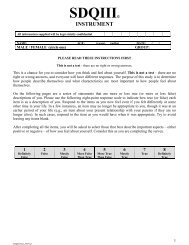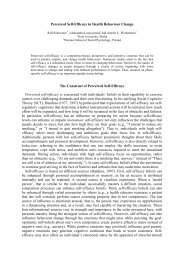Bodkin-Andrews, G, Craven, RG, and Martin AJ - SELF Research ...
Bodkin-Andrews, G, Craven, RG, and Martin AJ - SELF Research ...
Bodkin-Andrews, G, Craven, RG, and Martin AJ - SELF Research ...
Create successful ePaper yourself
Turn your PDF publications into a flip-book with our unique Google optimized e-Paper software.
within the confines of SEM as “a ubiquitous phenomenon that can produce strange, misleading, or uninterpretable<br />
results when a set of highly related independent variables is used to predict dependant variables (Marsh, et al., 2004).<br />
To overcome this difficulty, a full CFA including all the SMES factors <strong>and</strong> academic outcome variables was also<br />
conducted, thus bypassing misleading ‘predictions’. Instead, factor relations were used to assess what relations the<br />
various SMES factors may have held with the academic outcomes. As can be seen in Table 3, a large number of<br />
significant relations were identified, all of which sit well within the theoretical implications of the SMES. All adaptive<br />
dimensions were positive <strong>and</strong> significantly related to academic outcomes, suggesting that as Indigenous students’<br />
adaptive motivations strengthen, so does their ratings of school enjoyment, perceived instrumentality educational<br />
aspiration, student-self <strong>and</strong> perceived teacher-ratings, tentatively attesting to the importance of each these<br />
motivational/behavioural constructs as significant path to academic success.<br />
With regard to the non-significant relations between the impeding factors (anxiety, low control, <strong>and</strong> failure<br />
avoidance) of the SMES <strong>and</strong> academic outcomes, this is not, in isolation, surprising or completely inconsistent with<br />
previous research. For example, in a comprehensive analysis by <strong>Martin</strong> (2004), who utilized government, independent<br />
<strong>and</strong> secondary school students, it was found that they held only low correlations with the subjective academic outcomes<br />
measures including future academic plans, class participation, <strong>and</strong> school enjoyment (correlations ranged from -.27 to<br />
.05). Indeed, in returning to <strong>Martin</strong> <strong>and</strong> colleagues (2003) previous longitudinal defensive pessimism research, it can be<br />
seen that time-one relations between defensive expectations, defensive reflectivity, <strong>and</strong> uncertain control with future<br />
academic plans <strong>and</strong> grade-point-average were non-significant, yet time-two relations were significantly negative for<br />
uncertain control. Additionally, the defensive expectations component was negatively related to academic persistence<br />
<strong>and</strong> self-regulation over both time periods. The implications for this study is that to truly underst<strong>and</strong> the effects of the<br />
impeding factors within the SMES, one must examine a longitudinal time frame to utilizing the likes of uncertaincontrol,<br />
<strong>and</strong> one must also consider what relations the impeding dimensions may have with more adaptive motivations<br />
<strong>and</strong> behaviours over time.<br />
What relations the maladaptive dimensions (self-sabotage <strong>and</strong> disengagement) held with academic outcomes were<br />
all negative, <strong>and</strong> for the most part significant with the exception of the non-significant relation between self-sabotage<br />
<strong>and</strong> self-student ratings. These results cautiously allude to the negative impact both self-sabotage <strong>and</strong> disengagement<br />
have with a variety of outcome variables, especially for disengagement which was moderately related to school<br />
enjoyment <strong>and</strong> perceived instrumentality.<br />
Overall, the results are quite promising for not only elucidating what motivational behaviours <strong>and</strong> cognitions<br />
Indigenous students may hold, but also for identifying what impact these motivations may have on academic outcomes.<br />
But the results are far from conclusive. Firstly, the correlational nature of the study leaves little room for any causal<br />
inferences, but it at the very least does provide some useful directions for future research. Indeed, the large number of<br />
moderate to high relations between adaptive <strong>and</strong> maladaptive motivational dimensions with the academic outcomes<br />
utilized in this study does call for more precise longitudinal research that would allow an examination of causal paths.<br />
Additionally, considering that the outcomes utilized in this study were limited to self-report measures, it would also be<br />
plausible to investigate what relations SMES factors may hold with more objective outcomes such as st<strong>and</strong>ardized<br />
academic tests <strong>and</strong> teacher report ratings for Indigenous students.<br />
The largest limitation of this study though is the unresolved issue of the size of the relations between adaptive<br />
motivational factors. Although it is argued that this may have been due to particular method sampling inadequacies, no<br />
strong conclusions can be made to support this. Ideally, future research must precisely <strong>and</strong> efficiently target a realistic<br />
number of issues, rather than inundating students with what may seem to students as an endless array of similar<br />
questions. Invariance testing would also be required to examine the potential differences between Indigenous <strong>and</strong> non-<br />
Indigenous response patterns to the SMES <strong>and</strong> analysis should also seek to underst<strong>and</strong> how relations between the SMES<br />
<strong>and</strong> outcomes variables would also differ for Indigenous <strong>and</strong> non-Indigenous students.<br />
Conclusion<br />
This research has added weight to the suggestions of McInerny (2003) <strong>and</strong> Covington (2000) who both highlighted<br />
the need to underst<strong>and</strong> the motivational patterns of students beyond that of the simple mastery/task distinction, <strong>and</strong> this<br />
was achieved by identifying a large number of significant relations between Indigenous students’ academic outcomes<br />
<strong>and</strong> most facets of the SMES. It is important to note though, that any future attempt at examining these relations<br />
between Indigenous participants’ underst<strong>and</strong>ing of motivation <strong>and</strong> their relations with other outcome variables must<br />
also acknowledge the disadvantaged history Indigenous Australians have been forced to endure, <strong>and</strong> also the<br />
disadvantages of their minority status within the Australian setting. Pinning down the exact nature of the effects of a<br />
continually disadvantaged history is a difficult task, but one that must be acknowledged <strong>and</strong> strived to be understood. In<br />
the process, research that identifies the academic strategies <strong>and</strong> beliefs of Indigenous students should also provide a<br />
pivotal step for intervention, <strong>and</strong> ultimately contribute to extinguishing many of the inequities that still exist today.<br />
About The Authors





